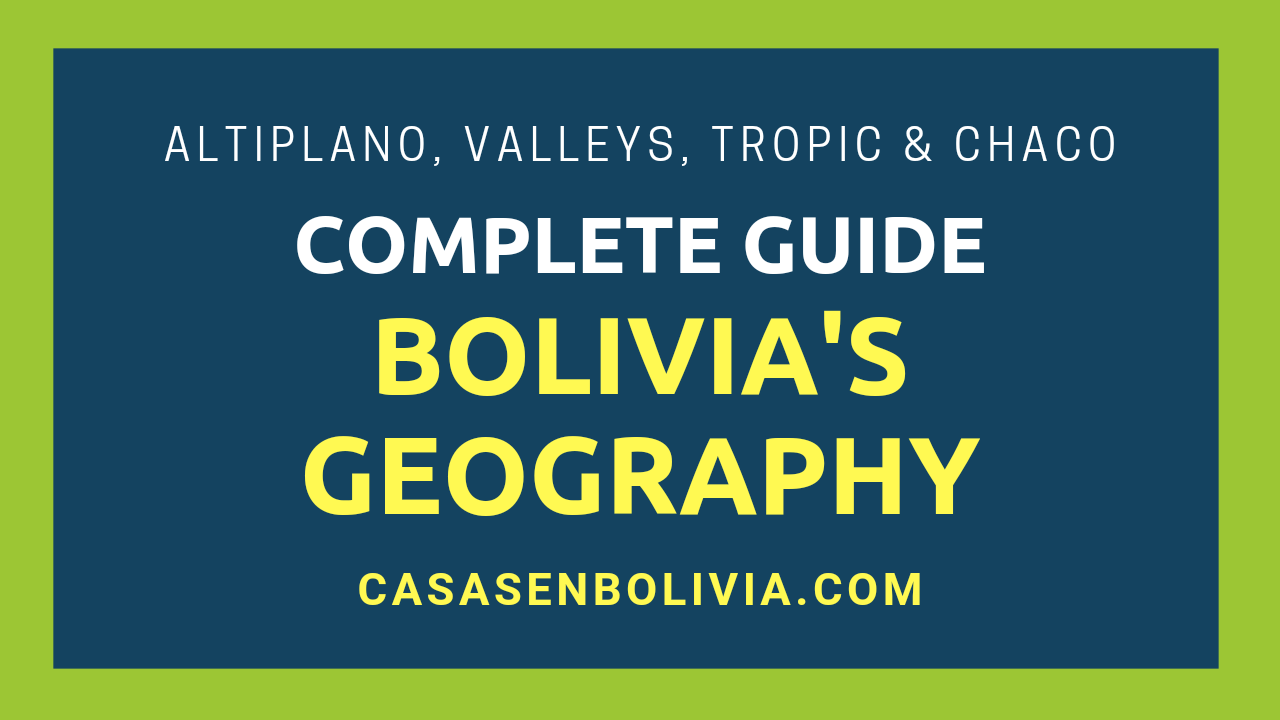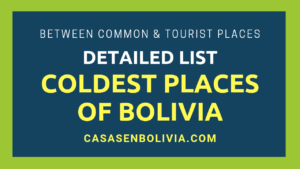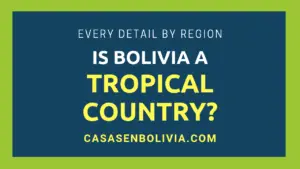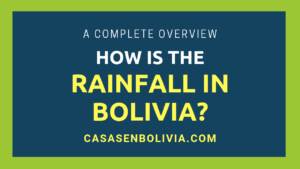Last Updated on February 15, 2025
Contrary to what many foreigners believe, Bolivia is not solely a high-altitude Altiplano country. In fact, the majority of the country is tropical, similar to Brazil. However, Bolivia also features a corridor of mountains that crosses the country from north to south, creating a very rugged terrain. The Chaco region in the south is also noteworthy.
Bolivia is divided into three distinct major geographical regions: The Altiplano in the west, a vast, high-altitude (13,000 ft/4000 m above sea level) plateau extending in all directions; the central chain of mountains and valleys, characterized by its rugged terrain; and the expansive, tropical lowlands to the east.
Here, we’ll discuss the geographical nature of Bolivia, its main geographical regions, the key features of each, and how they differ. You’ll learn about the cold, flat Altiplano, the tropical and Amazonian lowlands, the rugged central region of Bolivia, and the arid, flat Chaco in the country’s south.
Bolivia’s Three Main Geographical Regions
The Andes mountain range crosses Bolivia almost at its center. *This mountain chain divides the country between east and west*, creating two regions with completely different geographies.
Furthermore, *along the slopes of the Andes mountain range*, there’s a central corridor that traverses the country from north to south. This corridor is very rugged, filled with valleys, hills, canyons, and smaller mountains. It serves as a transition zone between the warm east and the cold west of the country.
As a result, *Bolivia is almost equally divided into three very distinct regions* in terms of geography:
- The high-altitude, cold, flat Altiplano in the west.
- The central corridor of temperate valleys, mountains, hills, and canyons.
- The warm, tropical, low-lying flatlands in the east.
Each of these three regions occupies a significant portion of Bolivia’s territory. The Altiplano accounts for about 28%, the central corridor of valleys and hills about 13%, and the tropical lowlands about 59%. *Therefore, Bolivia is predominantly a tropical country*, although the Altiplano also represents a substantial part. Additionally, the central rugged corridor, acting as a transition between these two regions, is considerably smaller.
These three regions differ significantly in:
- Average land altitude (ranging from 400 ft/100 m above sea level in the tropical lowlands to up to 16,500 ft/5,500 m in the Altiplano).
- Terrain ruggedness (from seemingly endless flatlands in both the west and east to countless valleys, mountains, hills, canyons, and plateaus in the central corridor).
- The number and complexity of lakes and rivers (from relatively simple systems with few lakes and narrow rivers in the Altiplano to highly complex systems with very wide rivers and numerous lakes in the tropical lowlands and the central corridor).
- Climate and temperature (ranging from near-freezing temperatures in the Altiplano to temperatures exceeding body heat in the tropical lowlands).
- Average rainfall (from minimal rainfall throughout the year in the Altiplano to almost Amazonian-like rainstorms in the tropical lowlands).
- Flora and fauna (from almost no wildlife in the Altiplano to incredibly diverse flora and fauna of all types in the tropical lowlands and the central corridor).
- Culture and lifestyle of the people (highly differentiated: the Collas in the Altiplano, the Cochalas in the central corridor, and the Cambas in the tropical lowlands).
Now, let’s examine these three geographical regions of Bolivia in more detail.
1) The High-Altitude Flatlands (Altiplano) in the West
This part of Bolivia is flat and at a very high elevation above sea level. It’s an arid region formed when a tectonic plate became trapped between two colliding plates, causing it to gradually rise over time.
A Vast, High-Altitude Plateau (Altiplano)
The Altiplano, meaning “high plain,” lives up to its name. While there, you’ll typically see an expansive, flat landscape stretching in all directions. It’s unlike other high-altitude terrains around the world, such as the Alps, where you won’t find such extensive flatlands.
Instead, you’ll find that the Altiplano appears to extend endlessly to the horizon. It’s also a relatively arid region located at a very high altitude (approximately 13,100 ft / 4,000 m above sea level), where foreigners often experience altitude sickness due to the lower oxygen levels. Nevertheless, around 3 million people currently reside there, in four major cities: La Paz, El Alto, Oruro, and Potosí.
The Andes Mountain Range Encloses the Altiplano
This mountain range splits into two large branches that encircle the high-altitude plain known as the Altiplano. It’s like a giant, dried-up lake, with its boundaries formed by these two branches of the Andes. Indeed, this lake was a reality in prehistoric times, and it shaped the current flatness of the Altiplano.
Therefore, what you’ll see today is a very flat, dry, elevated expanse that seems to stretch endlessly, with its boundaries defined by these two branches of the Andes mountain range. Within the Altiplano, you can also find some minor and smaller mountain ranges.
Extremely High, Snow-Capped Peaks in This Mountain Range
As mentioned, two branches of the Andes mountain range encircle the Altiplano. Some of these mountains reach very high altitudes, exceeding 19,600 ft (6,000 m) above sea level. These peaks tend to be snow-capped, and some are frequently visited by climbers and hikers. A few of these peaks are relatively easy to climb, but the majority are extremely dangerous. *Exercise caution in all these mountains*.
There, you’ll find some famous and also quite dangerous mountains. For example, Illimani, visible from La Paz city, is quite risky to climb. Another is Illampu, which is extremely dangerous to climb. Be cautious on all these mountains. Recently, there have been reports of tourists dying while attempting to climb some of these peaks.
Two Salt Flats: The Uyuni Salt Flat and the Coipasa Salt Flat
By far the most famous tourist attraction in Bolivia, the Uyuni Salt Flat, is located within the Altiplano, on its southern side. When you’re in the middle of this salt flat, it resembles a white sea surrounding you, reflecting the sky at night. It’s the largest salt flat in the world. However, there’s another, much less known salt flat about 75 miles (120 km) away: the Coipasa Salt Flat.
This second salt flat is not well-known and isn’t frequented by many tourists. Be careful to choose a reputable agency to visit the Coipasa Salt Flat, as it has less infrastructure around it, and almost no one lives there.
Two Large Lakes: Lake Titicaca and Lake Poopó
Lake Titicaca is well-known to tourists and is typically visited via two major towns, Copacabana and Desaguadero. It’s also located within the Altiplano, on its northwestern side. This is a very large lake with some interesting islands within it, such as the Island of the Sun and the Island of the Moon, often visited by tourists.
Until recently, there was also another lake, Lake Poopó, right in the center of the Altiplano. However, it has disappeared due to climate change and global warming. In its place, there’s now a tiny lagoon that continues to dry up. Be cautious when visiting this area; *there’s nothing to see there, and it’s quite desolate and potentially dangerous*.
A Major River Connecting Both Lakes
There’s also a major river connecting Lake Titicaca and the former Lake Poopó. However, in recent years, this river has become increasingly dry, primarily due to intensive water use by local communities. It starts relatively wide but eventually disappears somewhere within the Altiplano plains.
This river was once the main water source for Lake Poopó, and in the past, it even reached the ocean. However, nowadays, it doesn’t flow very far.
Significant Volcanic Activity and Volcanoes
On the southern side of the Altiplano, *there’s a complex of numerous volcanoes* and ongoing volcanic activity. The area is a protected zone called the Eduardo Avaroa National Park and is heavily visited by tourists. It’s also a popular side destination from the Uyuni Salt Flat, as it’s very close.
The part of the Altiplano region where this volcanic complex is located is at an even higher elevation of about 16,400 ft (5,000 m), but it’s still a flat expanse that appears endless, with some volcanoes or groups of volcanoes, geysers, and very interesting rock formations scattered around.
Indeed, these landscapes are so intriguing that some people describe them as otherworldly. There, you can also find the Red and Green Lagoons, extremely arid deserts like the Siloli and Dalí deserts, the Sol de la Mañana geysers, the Licancabur volcano, the Stone Tree, and more. It’s definitely a place worth visiting.
Small Deserts Are Present There
In this part of the Altiplano, the southern side, within the Eduardo Avaroa National Park, you can also find two extremely arid and small deserts, comparable to the Atacama Desert: the Dalí Desert and the Siloli Desert.
The Dalí Desert is very small, with about 42 sq mi (110 km²), but it’s one of the driest deserts in the world, and its landscapes are reminiscent of Salvador Dalí’s paintings. The Siloli Desert is larger and lies between the Uyuni Salt Flat and the volcanic complex, on the border between Bolivia and Chile. It features very interesting rock formations.
Four Major Cities Are Located in This Region
Despite the Altiplano’s very high altitude, around 3,000,000 people live there without any difficulty, in four major cities: Oruro and El Alto. These cities are situated on the Altiplano’s flatlands, with ample space to grow and expand. However, La Paz and Potosí are located within canyons in the middle of the Altiplano, making it challenging for them to expand, especially La Paz.
The main cities present in this region are:
- La Paz. 960,000 inhabitants. Elevation of 11,893 ft (3,625 m) above sea level.
- El Alto. 1,110,000 inhabitants. Elevation of 13,615 ft (4,150 m) above sea level.
- Oruro. 350,000 inhabitants. Elevation of 12,254 ft (3,735 m) above sea level.
- Potosí. 270,000 inhabitants. Elevation of 13,419 ft (4,090 m) above sea level.
2) The Mountainous and Rugged Central Corridor
This part of Bolivia *serves as a transition* between the very high-altitude Altiplano in the country’s west and the tropical and Amazonian lowlands to the east. Therefore, it’s a very rugged and descending terrain.
Rugged Terrain, Numerous Cliffs, Hills, Valleys, and Canyons
Huge and very steep cliffs are present in this region, all shaped by numerous rivers that transport water from the Altiplanic mountains and peaks to the tropical region. The terrain is composed of very hard rock, leading to the formation of deep canyons, cliffs, and majestic hills, along with exuberant flora and fauna.
Indeed, this region is one of the most biodiverse in South America, and it’s very humid throughout the year. Also, the roads that cross these mountain ranges are quite risky, and more vehicle accidents tend to occur, particularly in the Yungas region of the La Paz department, as some vehicles fall down the cliffs (*the Death Road is located in this region*).
A Region Called Yungas, Consistently Wet and Foggy
The Yungas region is a series of very steep canyons, valleys, and cliffs that often experience dense fog, making it difficult to see even beyond 30 feet (10 m). This typically occurs early in the morning but can happen at any time of day. It’s caused by humidity trapped among these canyons and blocked by the Andes mountain range.
Sometimes, this fog makes vehicle transit in these areas more challenging, as drivers have difficulty seeing through the fog. Nevertheless, this region is quite beautiful, and some interesting activities can be undertaken there, *such as cycling the Death Road*. Always find the best tourist agency to participate in this activity.
Large, Flat Valleys Between the Hills and Mountains
Within this corridor of hills, mountains, and canyons, you can also find many valleys. However, two of them are exceptionally large, featuring almost endless flat land within them: the Cochabamba city valley and the Punata valley.
These are very large valleys. *Cochabamba city is located within one of them*, surrounded by very high mountain ranges. However, the other one, Punata Valley, is even larger but is primarily a rural area with some surrounding towns, such as Punata, Arani, and others.
All of these are beautiful places to visit, *but be cautious: Chagas disease* is endemic here and throughout Bolivia’s central corridor of mountains and hills.
The Death Road and Many Dangerous Paths
As we mentioned earlier, a famous tour takes place here, the Death Road, which in the past had numerous car accidents, resulting in hundreds or even thousands of injuries each year. Nowadays, a modern, recently constructed road has replaced the Death Road, and it’s currently used only for tours and tourist biking.
But this is not the only path that exists here. In fact, there are countless paths winding through the hills, typically reaching various towns and clusters of rural houses. These paths are very treacherous, and it’s easy to get lost, as has happened to many tourists in the past. Therefore, hire a reputable tourist agency to visit these roads and locations.
Torotoro National Park (Caverns, Canyons, Dinosaur Footprints)
One of Bolivia’s most well-known tourist destinations, this park offers various attractions, such as caverns, cliffs, and hikes along authorized trails through the rugged terrain, as well as waterfalls and even dinosaur footprints. The landscapes are also delightful and interesting there.
This park also boasts significant biodiversity, as the climate in most of its areas is warm. You’ll find numerous mountains, valleys, plateaus, hills, cliffs, and waterfalls, connected by many dirt roads, all with a relatively pleasant climate. Always engage a reputable tourist agency to visit this park.
Warning: Chagas Disease in This Region
You must be extremely cautious *in this region and its rural areas and cities* due to the risk of “Chagas disease,” a serious illness that damages your heart, can be fatal, and often has no cure. It’s endemic in these cities (in Cochabamba, 35% of the population carries this parasite, and up to 54% in Sucre, as well as 48% in Tarija). Always seek living spaces *that are fully plastered, without any cracks, and take other precautions*. Be extremely vigilant!
Three Major Cities Are Located in This Region
This rugged part of Bolivia has a favorable climate and both large valleys and plateaus that concentrate most of the population living there. Cochabamba is situated within a very large valley, while Sucre and Tarija are on two also quite large plateaus.
The main cities present in this region are:
- Cochabamba. 860,000 inhabitants. Elevation of 8,392 ft (2,558 m) above sea level.
- Sucre. 360,000 inhabitants. Elevation of 9,219 ft (2,810 m) above sea level.
- Tarija. 270,000 inhabitants. Elevation of 6,083 ft (1,854 m) above sea level.
Be careful when visiting these cities and places, as Chagas disease is endemic in this region. Link
3) The Tropical or Amazonian Plains in the East
This part of Bolivia encompasses over 55% of the country’s territory, *meaning that Bolivia is predominantly tropical, not an Altiplano country*. This region is characterized by being a very flat, Amazonian-like land, at a low altitude, very humid, with abundant biodiversity, and only slightly drier than the Amazon itself. In fact, part of the Amazon rainforest is located within Bolivia’s northern side.
An Endless Tropical Flatland Everywhere
If you stand in the middle of this tropical region, you’ll see *nothing but a sea of wildlife on an endless flat terrain*, with no hills or rugged terrain on the horizon. And this is how over 55% of Bolivian territory actually is. Moving through these lands, you’ll occasionally encounter wide, mighty rivers and swampy areas.
Although there are some very low-lying mountain ranges in the tropical east of Bolivia, in most areas, regardless of the direction you travel, the terrain remains completely flat, hot, and humid. Continue east or north, and you’ll reach Brazil and the Amazon; go further, and you’ll reach the Atlantic Ocean.
Bolivia’s tropical lowlands are heavily crisscrossed by rivers of all sizes in all directions, all flowing towards the northeast to the Atlantic Ocean. These rivers are partially fueled by the descending water from the Andes mountain range and the Altiplano to the east, but also by the heavy rainfall throughout the year.
Some major rivers in this part of Bolivia are so wide that large boats can navigate their waters, such as the Madera, Madre de Dios, Mamoré, Guaporé, and many others. These rivers can range from 0.2 to 1 mile (0.3 to 1.6 km) in width, and many eventually feed into the Amazon or other very large rivers on the eastern side of South America.
A Large Swampy Region
Starting from the center and extending through the northeast of Bolivia within these tropical lands, there’s a region that is very often partially flooded. It contains the world’s largest wetland, called El Pantanal, which remains flat in all directions.
Despite this, a major Bolivian city, Trinidad, with approximately 170,000 inhabitants, is located near this swampy area. For this reason, parts of this city often flood at the end of the year, primarily in neighborhoods and areas where lower-income individuals reside.
Amazonian Humid Rainforests in the Northeast
In northeastern Bolivia, near the borders with Brazil, we find ourselves within the Amazon, a very wet, hot, and seemingly endless flatland covered by one of the greatest biodiversities in the world.
This area is even more humid than the central and southeastern tropical parts of the country where Santa Cruz is located. As you may know, the Amazon rainforest is on very flat terrain at a very low elevation, around 1,000 ft (300 m), with almost no hills, mountains, or depressions.
The World’s Largest Wetland (El Pantanal)
In this Bolivian region, you’ll also find the world’s largest wetland, called El Pantanal, with an area of approximately 58,700 sq mi (152,000 km²). It’s located in the far east of Bolivia, as well as in western Brazil and northern Paraguay. It’s visited by over a million tourists annually.
Approximately 80% of this wetland becomes flooded with about 3 meters of water during the humid season each year. The terrain there is like a very subtle depression in the middle of South America. Very few people live within El Pantanal, but it’s teeming with both aquatic and amphibious flora and fauna. It also boasts the largest alligator and jaguar populations in the world.
Drier Yet Very Hot Savannas in the South (El Chaco)
The Chaco region in Bolivia is a very hot and sometimes quite arid, almost endless flatland located in the southern and southeastern parts of Bolivia. This is indeed a low-lying plain that *resembles a savanna more than a humid rainforest*. Annual precipitation is very cyclical, with a humid season but also a scorching and dry season.
The only difference between the tropical and Amazonian lands in the north and center of the country and El Chaco is that it receives significantly less rainfall throughout the year. However, in other aspects, such as terrain shape and elevation above sea level, both regions are almost identical. When in the Chaco, you’ll typically see nothing more than an endless, dry, and hot flatland in all directions.
Be cautious when visiting this region. *If you get lost, you could even face life-threatening situations*, as temperatures can sometimes reach 113°F (45°C) with no water sources nearby. El Chaco is also a very sparsely populated region with only a few small towns scattered across its lands.
There Are Three Major Cities in This Region
Bolivia’s tropical flatlands concentrate the largest population in the country, despite the high temperatures and abundant rainfall. These lands, primarily in the center and north of the country (not in the southern Chaco), provide ample space for agriculture, cattle ranching, the utilization of other natural resources, and the further expansion of existing major cities.
The main cities located in this region are:
- Santa Cruz de la Sierra. 1,900,000 inhabitants. Elevation of 1,312 ft (400 m) above sea level.
- Trinidad. 170,000 inhabitants. Elevation of 427 ft (130 m) above sea level.
- Cobija. 90,000 inhabitants. Elevation of 919 ft (280 m) above sea level.
Warning: Numerous Diseases in This Region
Bolivia’s tropical east is also an endemic region for Chagas disease (a potentially fatal illness that damages your heart and often lacks a cure, transmitted by the Vinchuca and similar insects). In fact, 22% of the population in Santa Cruz has this illness. There’s also a high risk of contracting malaria, dengue, and zika in this region, even within its cities.
You should always, without exception, use a mosquito net over your bed when sleeping at night, *regardless of whether you’re inside your house* (as 99% of people in this region do). Also, take other precautions that go beyond the scope of this article to prevent these illnesses from affecting you while staying or living in this part of the country.
Conclusions:
In this guide to Bolivia’s geography, you’ve learned that Bolivia is primarily divided into three major geographical regions: 1) the flat, high-altitude, and cold Altiplano in the west; 2) the central mountainous, rugged corridor that separates the Altiplano from the tropical lowlands; and 3) the tropical and Amazonian low-lying flatlands in the east of the country.
You’ve seen that on the Altiplano, almost everything is above 13,000 ft (4,000 m) above sea level. Despite this, the region is largely a flat expanse surrounded by imposing mountains and peaks. It also contains the Uyuni and Coipasa Salt Flats, Lake Titicaca, numerous volcanoes, two deserts, and four major cities: La Paz, El Alto, Oruro, and Potosí, with a combined population of over 3,000,000 inhabitants.
You’ve also learned about the central, very rugged, and mountainous corridor that divides the west and east of Bolivia. It features deep canyons, steep cliffs, endless valleys, and plateaus, crisscrossed by a complex network of countless rivers, along with a temperate climate. You now know that three of Bolivia’s main cities are located within a very large valley and on two large plateaus, with a combined population of about 1,500,000 inhabitants.
Furthermore, you’ve learned that in eastern Bolivia, you’ll find expansive, flat tropical lands with endless rainforests and no mountains or hills in sight, as well as massive, wide rivers everywhere. The climate is similar to that of the Amazon, though slightly drier and cooler. You’ll also find the world’s largest wetland there, El Pantanal. In fact, this region encompasses the majority of both Bolivian territory and population.
You also discovered that the Chaco region in the south is indeed a flat, low-lying area that differs from the Amazonian and other tropical lands in the north and center of the country primarily in its aridity and higher temperatures. This makes it unsuitable for major cities. However, it still supports significant cattle ranching and similar activities, along with small towns scattered across its lands.
Finally, you’ve been made aware that you need to take all necessary precautions to avoid endemic diseases such as Chagas disease and Dengue fever anywhere in the country except for the Altiplano region.
We hope this information has been helpful. If you’d like to learn more about Bolivia’s climate, including details on rainy and dry seasons, annual rainfall for different regions and cities, and the precautions you should take, please visit our dedicated guide: The Climate of Bolivia: A Complete Walkthrough.
CasasenBolivia.com, information on living, working, investing, and traveling in Bolivia.








